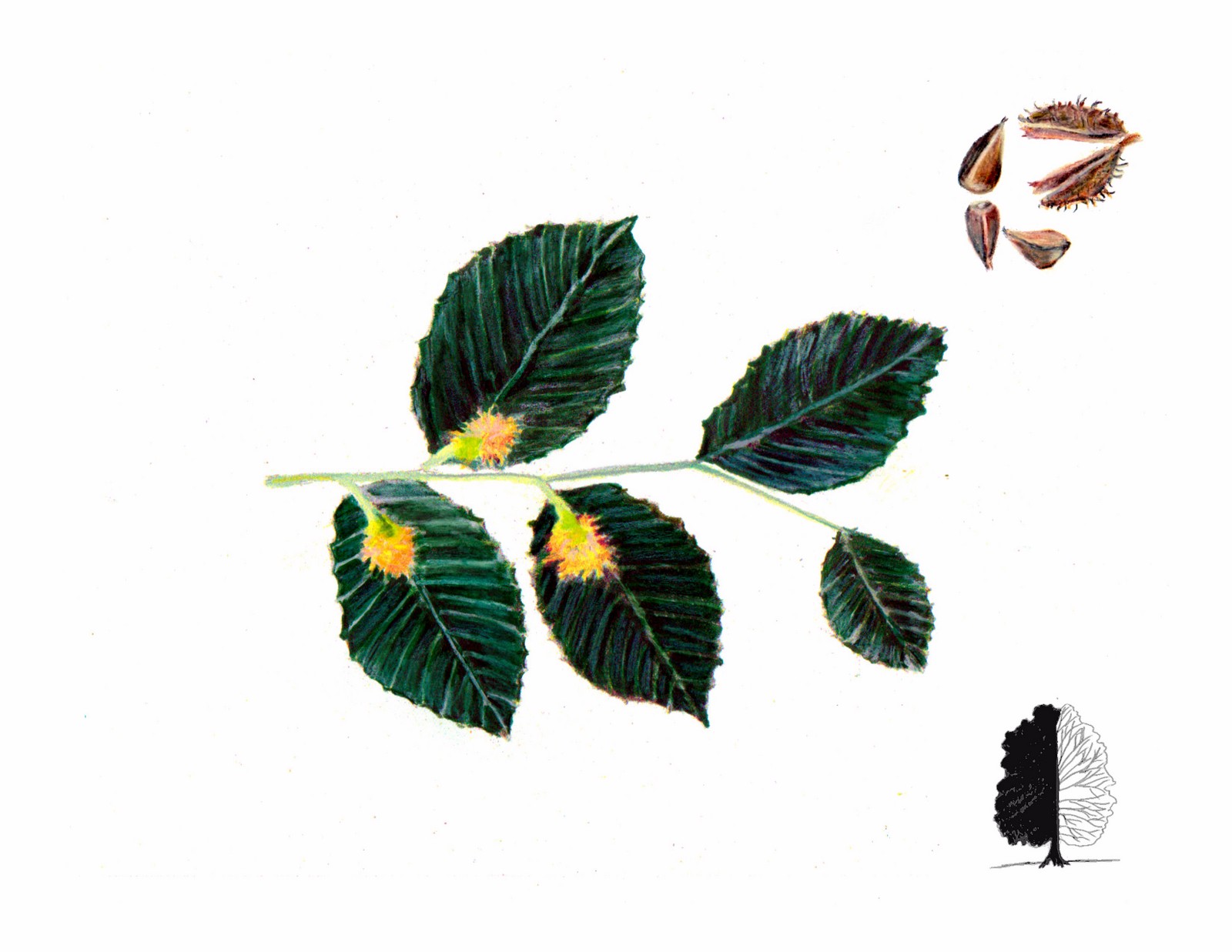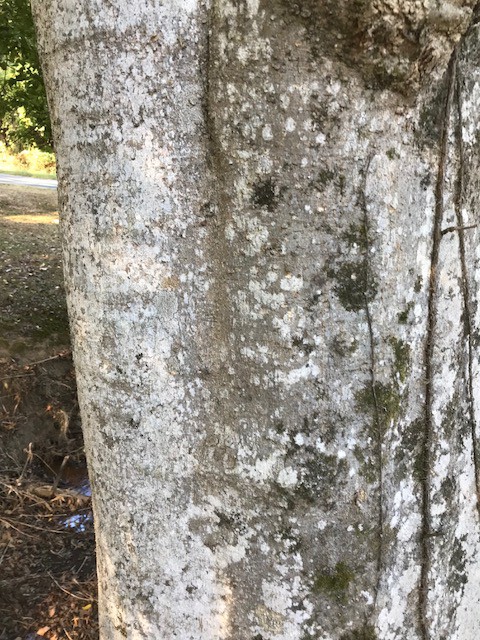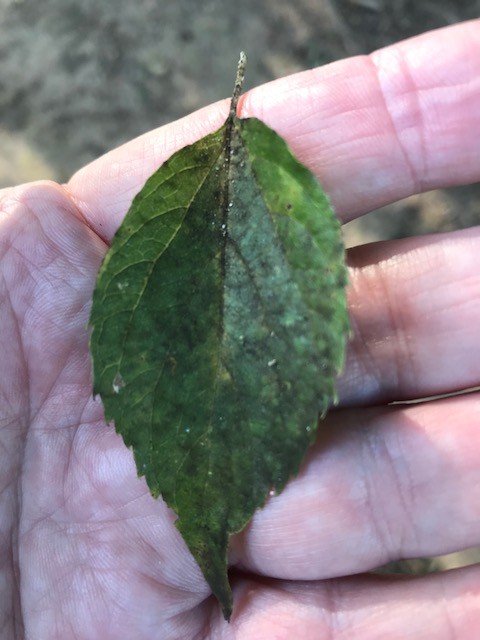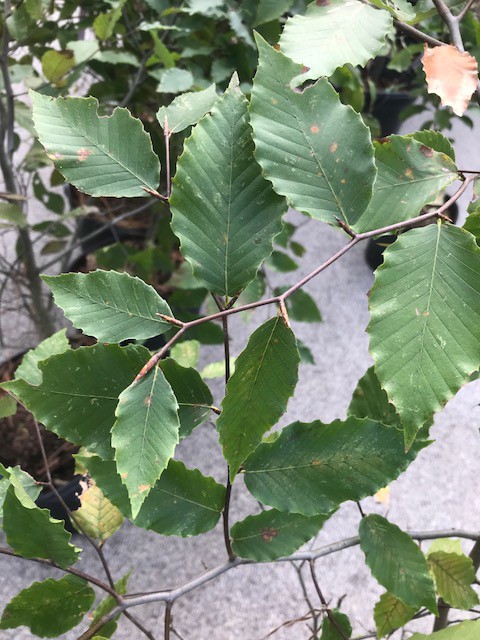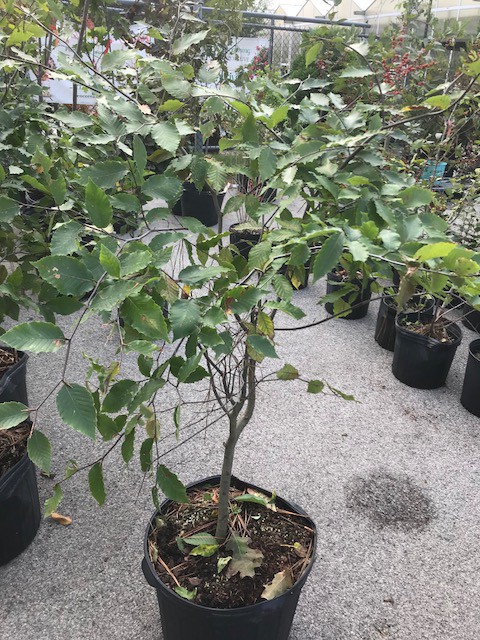American Beech
Fagus grandifolia
The beech tree is of such great significance to humankind that the etymological derivation of two common English words “to eat” and “book” are inexorably connected to it. Beech leaves and beechnuts (mast) were an important food source for both livestock and people alike in ancient times. The ancient Greek word for beech was phegos, which is related to the word phagein “to eat”. Phegos led to the Latin word fagus, which became the botanical genus name for beech trees because these trees are edible. The American beech is in the genus Fagus which is in the family Fagaceae.
Before the advent of paper scrolls, Germanic societies in northern Europe scratched early letters (manuscripts) on beech bark. Later, written manuscripts were preserved on thin beech tablets and bound together with beech wood boards. The Proto-Germanic word bokiz for “beech” became bok for “book”; this gave rise to the Old English (Anglo-Saxon) word boc for a written document, which in time became the modern English word book.
In several Germanic languages, the word for book and beech are still closely connected. For example, in modern German buche is beech and buch is book. The two words are even more similar in Swedish where bok is beech and bok is also the word for book.
One of the most common trees in the eastern North American forest is the American beech tree. It is an impressive tree with broad-spreading branches that sometimes reach the ground. Beech trees are slow growing and long lived. They usually take 40 years to mature enough to produce seeds and can live to 300 years or more. The beech grows to 50- to 80-feet high with a spread of 40- to 70-feet and can have 2- to 3-foot in caliper. The current champion tree is 120 feet tall.
There are 10 species of true beech trees and all grow in temperate regions in Europe, Asia, and North America. The American beech is the only beech tree native to North America.
Description
The American beech is a large deciduous tree with a dense, rounded, dome-like crown, broad-spreading habit with a tall straight trunk. The 3- to 6-inch long by 2-inch wide leaves are simple, ovate to elliptic in shape, and tapering to a pointed tip with sharply toothed margins. The glossy, dark green leaves are paler green underneath with tufts of hair along the mid-rib. The 9 to 15 pairs of veins are very distinct and run parallel to one another from mid-rib to the margin giving them a rippled appearance. Leaf buds are slender, cigar-shaped, and 1-inch long ending in a sharp pointed tip. Young stems are glossy with a reddish tint and grow in a zig-zag pattern. Older stems are smooth with a mottled gray color. The long- spreading branches grow horizontal and sometimes with their tips reaching the ground. The thin slate-gray to silver-gray bark is distinctively smooth most of its life and is ideal for carving. The male (staminate) flowers are ¾-inch to 1-inch long spiny clusters on 1 ½-inch to 2-inch stalks. The minute, reddish-green female (pistilate) flowers are ¼-inch long hairy and appear on 1-inch long stalks. Both flowers lack petals and emerge in early spring. The fruit are small greenish orange to brown round burs covered with short spines. When they ripen in September or October, the fruit will split open along four seams revealing 1 to 4 beechnuts inside. These yellow to reddish brown edible nuts are 1/4 to 3/8 inch long and conically shaped with winged edges. The shallow fibrous root system of the America beech has a suckering habit and will commonly send up root shoots in a colony around the parent tree.
Identifying Factors
Some common ways to identify the American beech tree are as follows: 1) the light brown leaves remain on the trees through most of the winter (marcescent), 2) the large trees have smooth light gray bark similar to an elephant’s hide, 3) the leaf buds are long and pointy, 4) it is one of the last trees to leaf out. 5) the leaves are rippled like Ruffles potato chips, and 6) the attractive fall foliage color is yellow-gold to bronze-brown.
Habitat/Range/Zone
American beech trees are found in forests, bottomlands, and ravines below 3,300 feet in altitude where there is moist rich soil. They range from central Georgia northward up the Atlantic coast to southeast Maine and Newfoundland, westward to the Great Lakes, southward to eastern Texas, and onward to the Gulf coast. It is thought by scientists that prior to the last ice age American beech trees ranged completely across the continent. There are still a few pockets of trees left in northeast Mexico. Beech trees grow best in USDA Zones 4 through 9, and there have been instances of them even surviving in zone 3.
General Culture
American beech trees grow at a slow to moderate growth rate. They prefer full sun but, are also extremely shade tolerant. American beech can be grown both farther north and farther south than their relative the European beech. They can withstand temperatures as low as -42-degrees Fahrenheit when dormant and summer temperatures as high as 105-degrees Fahrenheit. These trees will adapt to a wide range of soil from somewhat acidic to basic, but they prefer powdery limestone soils rich in organic matter with a pH from 5.0 to 6.5. They require ideally moist, well-drained soils and cannot tolerate waterlogged soils or prolonged drought. The American beech favors fertile soils with a high oxygen content that are not too heavy or compacted.
Irrigation & Fertilization
American beech always need moisture available to their roots and use twice as much water as more drought tolerant species like pines and oaks. For this reason, newly planted beech trees should be watered daily until they are well established. A moist root zone can be more easily maintained by applying 2 to 3 inches of mulch around each tree from the trunk out to the drip line at the outer edge of the canopy.
Beech trees need to be fertilized twice yearly in order to ward off infections such as beech bark disease. For every 100 square feet of root zone, use a pound of 10-10-10 (N-P-K) granular fertilizer. The root zone extends a foot or two beyond the drip line. Spread the fertilizer evenly over the root zone then water it in thoroughly. Apply the first application in late March and the second in early August.
Pruning
Young beech trees must be well trained to avoid instability in strong winds as they age. While young, prune beech trees for a strong central leader. As the crown develops, remove any upright lateral branches that might compete with the leader. Do not prune away any of the lower lateral branches until the trees are 6 to 8 years old. These lower branches will protect the tree from sunscald on the sensitive young bark. For mature trees, prune for good structure, and if in an urban setting, prune up limbs so pedestrians and vehicles can pass beneath easily. During weekly maintenance, clip away the root suckers around the trees to keep the area neat. Most structural pruning is best done in late summer or early fall.
Pollination
Beech trees are monoecious, they carry both male and female flowers on the same plant. Staminate or male flowers are drooping 1-inch catkins borne on 2-inch long stalks. Pistilate or female flowers are tiny ¼-inch inflorescences that lack petals and emerge in pairs on 1-inch long stalks. Both male and female flowers appear shortly after the new leaves come out in March or April. Wind is the primary carrier of beech pollen.
Propagation
American beech trees are extremely difficult to propagate by any form of vegetative propagation whether it is by cuttings, tissue culture, or grafting. The easiest and most popular method of propagation is by sowing seeds. First collect the seeds (nuts) in late autumn within a 50-mile radius of where you will be planting the new seedlings; this is to ensure that the seedlings will be genetically acclimated to area’s soil and climate. Choose seed pods that are dried and have already started to open naturally. Put the seeds into a bowl of water to clean the debris and check for viability. Discard any seeds that float as they will not germinate. Let the seeds dry for a day or two at 65- to 75-degrees Fahrenheit, then place them into plastic baggies of moist sand. Push the seeds down into the sand. Place the baggies of sand and seeds into a refrigerator set at 41-degrees Fahrenheit for the next 90 days. After this stratification period, remove the seeds from the baggies of sand and rinse the seeds off with water. Plant the seeds into 4-inch pots of seed starter soil mix. Sow one seed per pot. Place the pots in a room with bright indirect sunlight and a temperature of 70- to 75-degrees Fahrenheit. Mist the soil when it appears dry. Once the seeds have germinated and are showing three true leaves, water the seedlings with a mixture of ½ teaspoon of 10-10-10 (N-P-K) liquid fertilizer per gallon of water. Apply this fertilizer every two weeks. When the seedlings are 8 to 10 inches tall, transplant them into 1-gallon pots using a standard potting soil. In mid-May, when there is no threat of frost, start moving the potted seedling outdoors into an area with filtered sunshine. Let the seedlings stay outside till late fall, then move them indoors next to a sunny window for the winter. In the spring of their second year, plant the seedlings outdoors in an open location where they will get at least 6 hours of full sun per day with plenty of room to spread out.
Pests & Diseases
The long-lived American beech is rarely affected by pests and typically disease free, but there are several insects that can attack them such as giant bark aphids, beech blight aphids, wooly beech aphids, caterpillars, oak weevils, mites, leaf miners, pear thrips, gypsy moths, beech borers, beech lacebug, leafhoppers, and beech scale. Beech scale can penetrate the bark and make the tree susceptible to beech bark disease, a devastating canker disease that is infecting mature trees across the country. Some other diseases that can strike beech trees are bleeding bark canker, butt rot, leafspot, powdery mildew and root rot.
General Problems
When young, American beech trees are vulnerable to winter sunscald. They also transplant poorly due to having a long tap root. Mature trees are sensitive to early frosts. Early frosts can retard growth causing decreased nut production the next year. The trees can be damaged by strong winds, sapsuckers, and squirrels. Beech trees do not grow well in urban areas where the air is high in sulfur dioxide or carbon monoxide. The shallow root system can be easily disturbed by lawn mowers or tillers. This shallow dense root system makes it nearly impossible to grow grass or perennials underneath the trees. Fruit and husks can make messy litter on sidewalks and streets.
Harvest & Storage
Beech trees are late bloomers in the plant world, they don’t start producing nuts till around 40 years of age, but by 60 years old they are producing large crops of beechnuts. Once producing, they only produce abundant crops in cycles about every 3 years.
In late fall, just after the first frost, the forest floor under beech trees is usually covered with their spiny Velcro-like husks containing the nuts. Gather the nuts by hand and rub them between towels to remove their outer husks. Once the outer husk is removed, spread the nuts out in a single layer on newspaper or a tarp in a well-ventilated, secure area away from chipmunks and other rodents for 2 to 3 weeks to cure. For long term storage, leave the nuts with their inner shells intact after curing. They will keep for over a year in this manner. Store them in rodent-proof glass jars in a cool dark place.
If using the nuts immediately, remove their leathery inner shells with your fingernails or teeth like shelling sunflower seeds or pistachios. There is a single beechnut inside each triangular shell, which are about the size of a popcorn kernel. The beechnut has a light brown papery husk that can be removed by using friction between towels. After picking out the papery husks, you are finally left with the small white nuts. Cook them in a pan for about 3 to 5 minutes. Roasting them in this fashion will improve their flavor and neutralize toxins in any remaining husks.
Culinary Uses
In colonial times, young beech leaves were cooked as pot greens or added to fresh salads. The young leaves picked early in spring have a soft texture and a pleasant, mild, nutty flavor. The beechnuts were also used as a food. Shelled nuts were roasted then added to breads and pastries. The kernels were also cooked and then ground into a butter or into a flour. They were also pressed into an edible cooking oil. Beechnuts are up to 50% oil. Non-alcoholic coffee-like beverages were made from boiled nuts and a liquor, like sloe gin, was made by soaking the leaves in gin for several weeks. In times of need, the inner bark of the beech tree was dried and ground into sawdust which was then added to flour as an extender. The aromatic bark and wood have been used to improve the flavor of beers, thus the term “beechwood aging”. Beechwood is also used to cure hams, sausages, and cheeses.
Nutritional Benefits & Medicinal Uses
Beechnuts are one of the three most nutrient-dense nuts. The other two, acorns (oak) and sweet chestnuts are also in the Beech family, Fagaceae. Beechnuts are a good source of vitamins, minerals and other nutrients. These nuts are especially high in amino acids such as tryptophan, leucine, and lysine. Beechnut oil made from the nuts contains up to 23% protein and is also rich in vitamin B6, potassium, and manganese. The leaves have also been eaten for hundreds of years and are rich in minerals, starch, and protein.
Native Americans have long known the antiseptic, disinfectant, and analgesic properties of the beech tree. Parts of the beech tree have been used for medicinal purposes by Native Americans, as well as, Europeans for centuries. Eating the leaves can help improve digestion. Poultices made from beech leaves can be used to soothe minor burns, relieve headaches, ease swelling, and to treat frostbite. A tar or creosote, made from distilled beech branches, can be applied topically to relieve wounds or inflamed areas of skin and to protect them from infections. This creosote has both analgesic and antiseptic properties. A tea brewed from dried inner bark has been used to treat tuberculosis, as a blood cleanser, and to boost the immune system with its antioxidant properties. Decoctions made from beechnuts have been used to cleanse the body of toxins by stimulating kidney function.
Native American Uses
Although many native peoples used beech nutmeats for food, no other people had as many culinary uses for them as the Iroquois did. The Iroquois made breads by mixing crushed beech nuts with cornmeal, berries, and beans. Pies were also cooked combining beech nuts and corn pudding. The Iroquois people made an oily drink by crushing and boiling the nutmeats. A gravy was made by salting and seasoning the oil from the nuts. The Iroquois also garnished mashed potato dishes and corn soup with crushed beech nuts.
The Chippewa, Tsalagi, and Potawatomi tribes carefully followed chipmunks and deer mice back to their burrows in the fall to rob their stores of beech nuts. The rodents had usually already cleaned and culled through the nuts so only the best nuts were hoarded.
Many tribes also used the wood of the beech tree as building material for lodges and as fuel. The Cherokee used the wood for lumber and to make buttons. The Micmac people utilized beech wood for snowshoe frames and the Potawatomi made beech wood bowls and other cooking utensils.
Some tribes mixed beech nut oil and bear grease to make mosquito repellant.
Ornamental Uses
The dried light-brown leaves hanging on their branches through most of the winter is thought by many to be an attractive feature of beech trees. The beech tree is best utilized as a specimen tree or shade tree in large landscape designs. It is better to limit their use in urban settings. They eventually become too large for smaller properties, but are well suited for naturalized areas on large lots, in parks, or at the edge of forests. When mature, these trees cast too much shade for any companion plants or a lawn to survive underneath them, so mulch the ground underneath them out to the edge of the drip line and routinely prune out the suckers as they appear.
Other Uses
The American beech has long been considered an important timber species. Although their wood is not very durable, it is hard, strong, and widely used for many applications. It has been used to make containers such as barrels, bowls, flooring, veneer, toys, musical instruments, furniture, buttons, pins, kitchen utensils, tool handles, and shoe stretchers. It makes an excellent firewood for heating or cooking on wood stoves because of its good burning properties and high density. In colonial times, the wood was used to make charcoal and the ashes were used to make soap. The nuts were used to make lamp oil and as a furniture polish. The leaves were used to feed livestock and the nuts were used as pig fodder. These trees are also a significant source of food for wildlife such as mice, chipmunks, racoons, foxes, deer, bears, quail, ducks, and wild turkeys. The beech tree is also a larval host for several butterfly varieties. The trees are used as windbreak hedging since they hold their dead leaves well into winter thus providing extra wind protection. A modern textile fabric, Modal, is made from reconstituted cellulose from beechwood pulp. The leaves and bark have also been used to make yellow and brown fabric dyes.
Recommended Varieties
There are currently no known commercial varieties of American beech in the green industry. Plant breeders and collectors are currently making selections of unique individual trees with unusual foliage or habit. Briefly in the 1920s, there were two selections, ‘Abundance’ and ‘Abrams’ made in Indiana. Then, in the 1950s there was a selection made in New York called ‘Jenner’. But, none of these selections ever caught on in the commercial trade and are not available today.
Related Species & Varieties
The American Beech is one of 10 species of Beech in the Northern Hemisphere. The most well known of these is the European Beech, Fagus sylvatica. It is a native to central Europe and has been used more as an ornamental than the American Beech because of its handsome foliage. Some of the best selections of the European Beech are:
- Copper Beech, F. sylvatica ‘Purpurea’ – leaves start in spring as purple pink turning to a deep purple.
- Pendulous Beech, F. sylvatica ‘Pendula’ – has weeping branches sometimes trailing to the ground.
- Tricolor Beech, F. sylvatica ‘Tricolor’ – a good container plant with white/pink edged green leaves.
- Cutleaf Beech, F. sylvatica ‘Laciniata’ – has narrow, deeply-serrated green leaves.
Two other related species are the Oriental Beech, Fagus orientalis, and the Japanese Beech, Fagus crenata. The Oriental Beech originate in Asia Minor, have hairy twigs and can grow to 100-feet tall. The Japanese Beech is a common forest tree in its native Japan. It can grow to 115-feet tall and has attractive dark green ovate leaves.
Hazards & Cautions
Humans can eat beechnuts just like wildlife, but it is best not to eat too many in one sitting because these nuts contain a mildly toxic, detergent-like chemical that is saponic glycoside. When beechnuts are eaten in large quantities, this toxin can cause mild, rapid-onset gastrointestinal upset. Wildlife seem to be virtually immune to this toxin. There is another toxin, fagin, in the skin of the kernel or nut. Roasting allows the skin to be rubbed off and the potency of the toxin is also diminished. Raw nuts remain high in fagin so they are best avoided. Bark teas should not be used by pregnant or nursing women.
Summary
The American beech tree is a massive, stately, native tree of great importance in our early history. Although these trees are still quite common in forests throughout the Southeast, today the beech is mostly forgotten as a valuable food source and as a large landscape element. We would be wise to look upon the beech with reverence and remember all its many uses.
References & Related Links
Adamant, Ashley. September 28, 2018. Foraging Beech Nuts. Practical Self Reliance| retrieved from https:// practical self reliance.com/foraging-beech-nuts/
Bender, Steve. The New Southern Living Garden Book. New York: Oxmoor House, 2015.
Brickell, Christopher and Joyce, David. Pruning and Training. New York: Dorling Kindersley Limited, 2017.
Grimm, William Carey. The Illustrated Book of Trees. Mechanicsburg, PA: Stackpole Publishing, 1983.
Hageneder, Fred. The Meaning of Trees. San Francisco: Chronicle Books, 2005.
Head, Bob H. Hutchinson’s Tree Book – A Reference Guide to Popular Trees. Taylors, SC: Hutchinson Publishing, 2006.
https://www.healthbenefitstimes.com/beech-nut. Health Benefits Times, 2017.
Kershner, Bruce; Matthews, Daniel; Nelson, Gil; Spellenberg, Richard. National Wildlife Federation: Guide to Trees of North America. New York: Sterling Publishing, 2008.
Kirkman, L. Katherine; Brown, Claude L.; Leopold, Donald J. Native Trees of the Southeast – An Identification Guide. Portland: Timber Press, 2007.
Moerman, Daniel E. Native American Ethnobotany. Portland: Timber Press, 1998.
Nix, Steve. March 20, 2019. Essentials for Tree Seed Propagation. Thought Co. retrieved from https://www.thoughtco.com/essentials-for-the-seed-propagation-1343274?/
Petrides, George A. Peterson Field Guides – Eastern Trees. New York: Houghton Mifflin, 1998.
Staughton, John. October 08, 2019. 7 Interesting Benefits of Beech. Organic Facts| retrieved from
https://www.organicfacts.net/health-benefits/other/beech.html
Sternberg, Guy and Wilson, Jim. Native Trees for North American Landscapes. Portland: Timber Press, 2004.
Westover, Jessica. (n.d.). How to Grow Beechnut Tres From Seeds. Home Guides | SF Gate. Retrieved from http://homeguides.sfgate.com/grow-beechnut-trees-seeds-68022.html
Suppliers
- ArcheWild Native Nurseries – Quakertown, PA.
- Native Forest Nursery – Chatsworth, GA.
- Edge of the Woods Native Plant Nursery – Orefield, PA.
- Mid Atlantic Natives – Cobbs Creek, VA.
- Rock Bridge Trees – Bethpage, TN.


